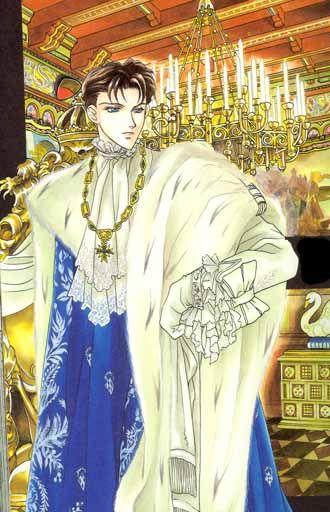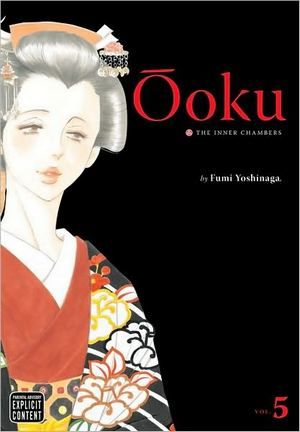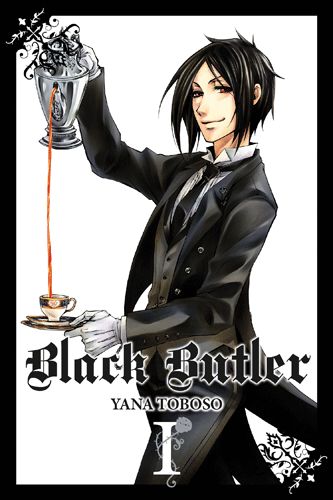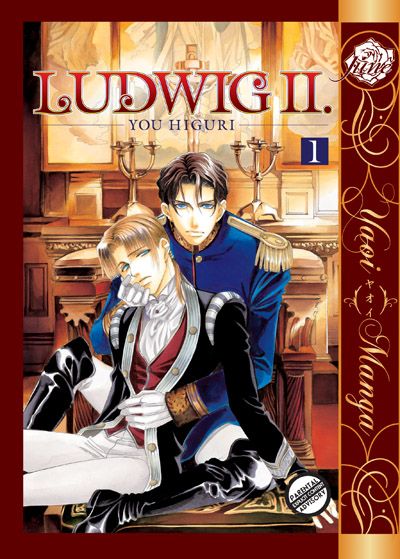It's fair to say that I use these topics to tie three unrelated series together for no real reason. I enjoy this format, because it gives me a chance to take the good with the bad, and to force myself to dredge up series I may have read eight years ago and completely forgotten. This topic is particularly arbitrary, and is broad enough to use again. But for now, here's a look at three real people depicted fictitiously in manga. Unfortunately, I have no American Presidents for you (I was initially going for a more general bio-manga theme). I couldn't think of any series where a real President was a primary character. Golgo 13 and Adolf, which I've already talked about, have Presidents in bit parts. There is Eagle, about a fictitious Japanese-American President running against fictitious Al Gore, but I haven't read it, and it would feel unfair to summarize such an ambitious work in one paragraph with no personal knowledge. But here's three I have read, one from ancient Japan and two from late 19th century Europe.
Ooku: The Inner Chamber - Fumi Yoshinaga (8+ volumes)
Ooku is a true treasure, and among the most literary manga you'll find in English. The rulers in this case are the real-life Tokugawa Shogunate of Japan. The Shogun aren't technically monarchs, as Japan is still "ruled" by the Emperor during the Shogunate period, but the Shogun were warlords that governed the country. The Tokugawa period covered by this series starts in 1603 with Tokugawa Ieyasu, and presumably runs through 1868, with the end of the Shogunate government. Rather than a literal biographical work, Yoshinaga introduces a disease which wipes out almost all men in Japan during infancy, so that women are left to work and govern, and men are kept as a precious resource meant only to conceive children. Thus, in this series, all the Shogun are women, though the personality and historical details are maintained. It does focus on government and how well or poorly each of the Shogun rulers fares. But it runs in a women's magazine, and with the reversed gender roles, we see a lot about the personal lives of the Shogun as well. The title of the series refers to the harem the Shogun keep, which contains more men than the rest of the country combined. There are some tawdry stories related to the various Shogun's relationships with the harem over the years, but just as much focus goes to the fact that all of the Shogun have trouble conceiving children, and continuing their line weighs heavily on them. It's also interesting to see the female role in government, and how well they do it. Some Shogun are easily manipulated by their fathers or those around them. Some are completely uninterested in running the country. Some are very good at it in their own right. The issue of the male gender being scarce comes up several times throughout the series as well, always with interesting (but as yet inconclusive) results. There's usually personal details included with most of the Shogun, such as a debilitating speech impediment for Ieshige. The series is fascinating as a whole because of the variety of stories it tells. For instance, Yoshimune brings up the issue of the male sickness again in relation to it being a possible weakness should they engage in international relations. The lack of men is also an interesting explanation as to why Japan was "closed" until the end of the Shogunate. Yoshimune's story takes up the second half of volume 7. The first half is a tragic story about some politically-motivated backstabbing involving a popular actress and one of the members of the inner chamber, completely unrelated to the Shogunate storyline. Meanwhile, the ruling Shogun were two sickly children who died in early childhood. There's a lot going on in this series, and it makes for an incredibly interesting read. Yoshinaga's art is adored by some, and she includes vast amounts of period detail in this work. But I've always found it to be a very solid, easily read style that works well here, especially with some of the no-nonsense Shogun. Yoshinaga also has a broader range of facial expressions. The downside to Ooku is that it isn't written for people unfamiliar with Japanese history. It's heavily annotated, but it still makes for complicated reading. Downside number two is the adaptation. Yoshinaga uses a more ancient dialect of Japanese for this series, which is unfortunately represented in English with Eary Modern English. Many people find this jarring, and I find it takes me out of the story due to the fact that the characters aren't actually in 17th century England. The last point against it is the fact that only one volume comes out a year. With such a dense story, it can take me awhile to remember what's going on. It's definitely worth it, but it's hard to say how much longer it will go on. Yoshinaga projected 10 volumes, but since we are currently up to 1745, it seems like it might run longer. All volumes are currently in print and available, and Viz is still faithfully releasing one new volume a year, the same pace it comes out in Japan.
Black Butler - Yana Toboso (16+ volumes)
Here, the link to the monarchy is tenuous, but I've always privately enjoyed the fact that Queen Victoria has a 12-year-old boy running the London underworld. For one volume, Black Butler seems to be a comedy about the wacky antics of Earl Ciel Phantomhive's dim-witted servants and his savvy butler's uncanny ability to fix their mistakes. It's got almost unbearable humor, until it's revealed at the end of volume one that the butler, Sebastian, is actually a demon that Ciel bound to him while he was being sacrificed in some sort of horrible black ritual. Sebastian will do anything Ciel asks of him, with the promise that he will be allowed to consume Ciel's soul when Ciel dies. And Sebastian really can do anything. He has superhuman strength and speed, but he's also very clever, and can seduce any sort of information out of anybody. He protects Ciel increasingly from demons and more nefarious foes as the series continues. The best thing about Black Butler is that it goes from being almost unreadable to increasingly evil and haunting with each storyline. A recent plot about a band of traveling circus performers that kidnap children in order to sacrifice them was particularly dark, especially given how every single one of the performers was manipulated as a child, and into adulthood. Even the inept servants become unbelievably awesome in that story, which I didn't think Toboso could pull off. It still has its share of cringe-worthy humor, but as a stylish and dark fantasy story, it's quite good. Toboso has wonderful art, and lavishes particular attention to the clothing the characters wear. Victorian England rarely looks so good in comics. Her action scenes and otherworldly creatures are also quite good, and she uses a lot of heavy ink and lets the comic flow quite well. The most recent plotline in English ran for several volumes, and was an elaborate whodunnit murder mystery contained within one house, starring fictitious Arthur Conan Doyle. Going back to the article's theme, Queen Victoria is essentially Ciel's boss, and the storylines are all things she asks him to investigate. She is mostly faceless for several volumes, but appears as a very cheery and loving older woman earlier on. Again, the fact that Queen Victoria has a 12-year-old taking care of dangerous matters for her amuses me so much that I thought of this series before Ooku when I came up with this topic. Black Butler is one of the best-selling manga in English, and all volumes should currently be available.
Ludwig II - You Higuri (2 volumes)
You Higuri is a wonderful artist, and loves drawing period costumes and settings. She also loves historical research and love stories, and there are four series in English that highlight these talents quite well. Gorgeous Carat is the more fictitious one, an action-romance about a pair of wealthy Paris aristocrats that reads like the boys' love equivalent of Indiana Jones. Angel's Coffin takes the story about the mysterious lover's suicide of Baroness Mary Vetsera and Crown Prince Rudolf of Austria and retells it with a demon, but the circumstances of the real-life event are intact, and it's such an obscure point of history that it makes for interesting reading, demon or no demon. Cantarella tells the fictitious story of the Borgias, casting Cesare as a demon. That one's convoluted, but very pretty. Ludwig II is my favorite by her in English, and tells the story of the mad Bavarian King Ludwig II. Higuri romanticizes his life excessively, but judging from the real-life story of Ludwig II, this is only appropriate. In the series he is depicted as a capable ruler, but is only interested in building a beautiful fantasy world for himself. The only thing that keeps him grounded in reality is his gay lover Hornig, a stablemaster (Ludwig II ran in Asuka, which has a knack for male/male romantic overtones). Otherwise, Ludwig loses himself in the fantasies of his extensive castles, the music that he commissions from Wagner, and, basically, a beautiful life. He feels he needs these things to contrast the dark political situation in Europe at the time, and the story goes on to explain that he was forcefully deposed and replaced by his younger brother Otto, who in real life was confined to his house and unable to rule. His uncle Luitpold is regent, and more willing to play politics in the German Empire, something Ludwig was adamantly against. Unfortunately, the political situation is glossed over almost completely, with most of the dialogue dedicated to developing the romantic image surrounding Ludwig. And while his relationship with Hornig is very important to him, it's secondary to the rather outrageous story of his personal mystique. Each volume contains notes about research trips Higuri took to Bavaria, which contain some rather... memorable real-life Ludwig II memorabilia. Higuri's art here is among the best work I've seen by her, and she lavishes a lot of love and attention on the costumes, settings, and scenery, which is only appropriate for a story about lush excess. The downside here is that it's almost too involved with Ludwig as a person, and can be a bit tedious to read. But it is a very romantic portrait, and Higuri does a good job portraying the fantasy world Ludwig built for himself. I often see notes that the series is incomplete in English, but the two English volumes are omnibuses, and the series is complete. It was released almost 5 years ago, but both volumes are still available at online retailers.





